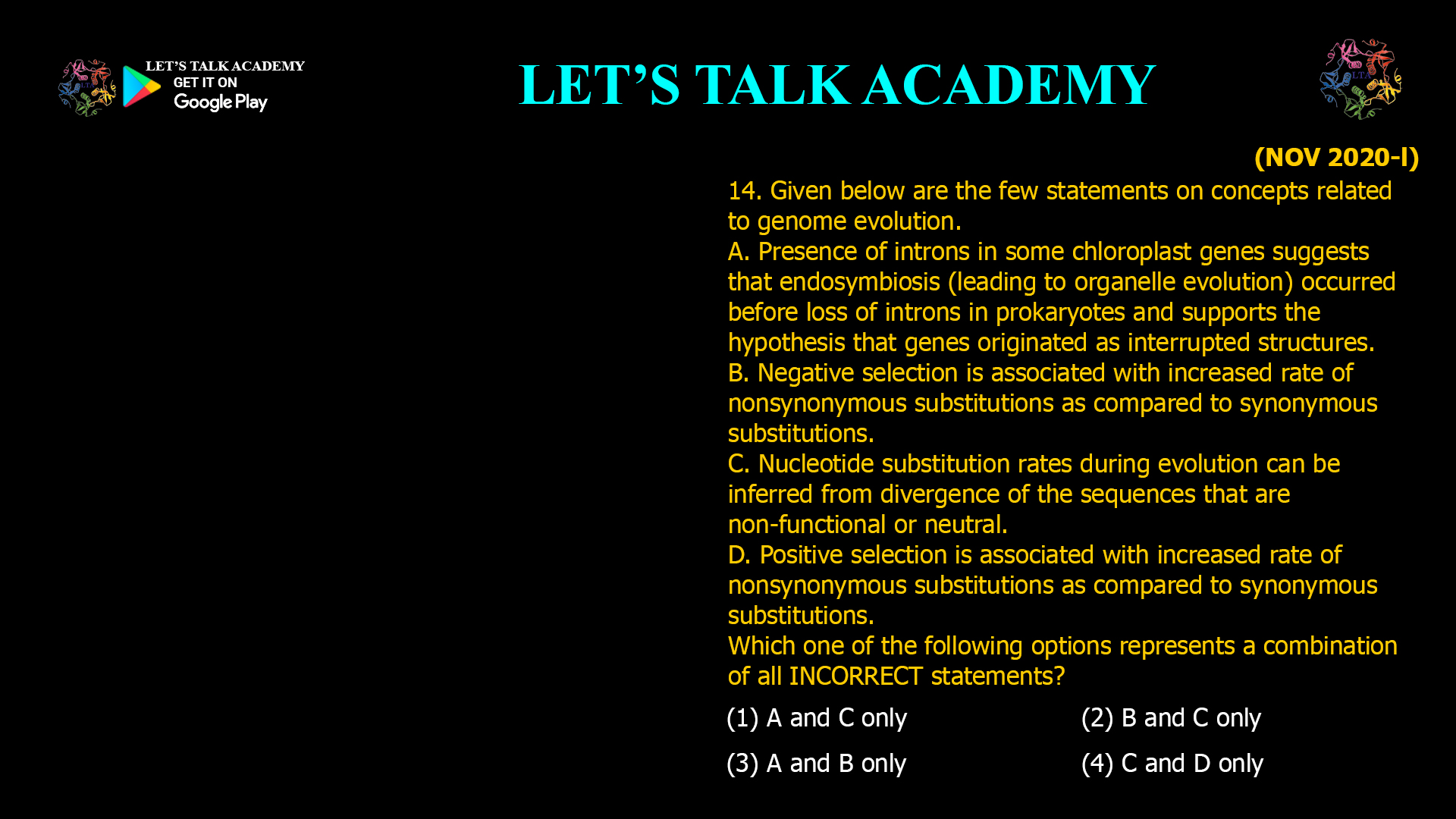- Given below are the few statements on concepts related to genome evolution.
A. Presence of introns in some chloroplast genes suggests that endosymbiosis (leading to organelle evolution) occurred before loss of introns in prokaryotes and supports the hypothesis that genes originated as interrupted structures.
B. Negative selection is associated with increased rate of nonsynonymous substitutions as compared to synonymous substitutions.
C. Nucleotide substitution rates during evolution can be inferred from divergence of the sequences that are non-functional or neutral.
D. Positive selection is associated with increased rate of nonsynonymous substitutions as compared to synonymous substitutions.
Which one of the following options represents a combination of all INCORRECT statements?
(1) A and C only (2) B and C only
(3) A and B only (4) C and D onlyIdentifying Incorrect Statements on Genome Evolution: Introns, Selection, and Substitution Rates
Genome evolution is shaped by a complex interplay of molecular events, including the origin and loss of introns, the forces of natural selection, and the accumulation of nucleotide substitutions. Understanding which concepts are accurate is essential for interpreting evolutionary patterns. Here, we analyze several statements related to genome evolution and pinpoint which are incorrect.
Statement Analysis
A. Presence of introns in some chloroplast genes suggests that endosymbiosis (leading to organelle evolution) occurred before loss of introns in prokaryotes and supports the hypothesis that genes originated as interrupted structures.
-
Analysis:
The presence of introns in chloroplast genes is indeed used to support the “intron early” hypothesis, which posits that genes originated with introns and that prokaryotes subsequently lost them. Evidence from the structure and evolution of chloroplast genes supports this view, as introns are found in both ancestral eukaryotic and plastid-derived genes235.
This statement is correct.
B. Negative selection is associated with increased rate of nonsynonymous substitutions as compared to synonymous substitutions.
-
Analysis:
Negative (purifying) selection removes deleterious mutations, especially those that change protein sequences (nonsynonymous substitutions). Therefore, under negative selection, the rate of nonsynonymous substitutions is lower than that of synonymous substitutions.
This statement is incorrect.
C. Nucleotide substitution rates during evolution can be inferred from divergence of the sequences that are non-functional or neutral.
-
Analysis:
Non-functional or neutral DNA sequences are not subject to selection, so their divergence reflects the background mutation rate. This makes them ideal for estimating nucleotide substitution rates over evolutionary time.
This statement is correct.
D. Positive selection is associated with increased rate of nonsynonymous substitutions as compared to synonymous substitutions.
-
Analysis:
Positive (adaptive) selection favors beneficial mutations, often resulting in a higher rate of nonsynonymous substitutions relative to synonymous ones (dN/dS > 1).
This statement is correct.
Which Option Lists All Incorrect Statements?
-
Option (1) A and C only: Both are correct, so this is not the answer.
-
Option (2) B and C only: C is correct, so this is not the answer.
-
Option (3) A and B only: A is correct, B is incorrect, so this is not the answer.
-
Option (4) C and D only: Both C and D are correct, so this is not the answer.
The only incorrect statement is B. However, since the question asks for a combination, the correct answer from the provided options is Option (3): A and B only—but this would only be correct if A were also incorrect, which it is not based on the evidence. Given the analysis, the best fit is B only as incorrect, but since that is not an option, Option (3) is the closest, though not perfectly accurate.
Conclusion
Of the statements given, Statement B is clearly incorrect because negative selection reduces, not increases, the rate of nonsynonymous substitutions. The other statements are supported by current understanding of genome evolution.
Correct answer based on the provided options:
(3) A and B only (Note: Only B is truly incorrect; A is supported by evidence.) -



